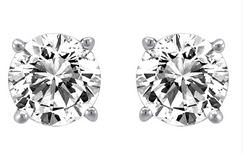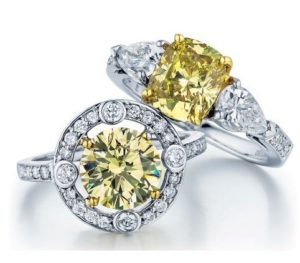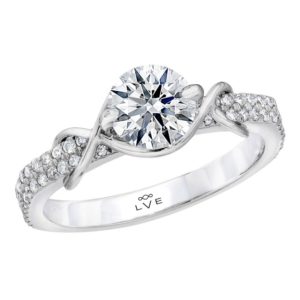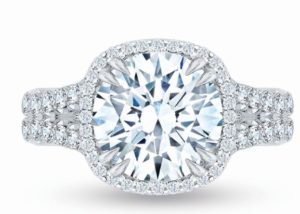Bestsellers, Fresh Sellers
Given the current climate of the diamond market, classic staples in wedding and fashion jewelry continue to reign, and brands that are engaging consumers with specialty cuts, fancy shapes and colors, fresh designs, and strong storylines are giving jewelers ways to stand out in the crowd.
 Diamond remains the hero, it never goes out of style, and you can have it and wear it for the rest of your life! Not surprising bread and butter styles like channel-set bands; studs, hearts and crosses; and solitaires are among the bestsellers, tells Grant Mobley, vice president sales, Simply Diamonds, Jewelmark, New York. “We probably sell more than anyone in the business in 1-carat total weight studs; 44% of our business is in studs. We also see solitaires becoming more popular, as it’s easy for retailers to show and sell, as opposed to loose stones.”
Diamond remains the hero, it never goes out of style, and you can have it and wear it for the rest of your life! Not surprising bread and butter styles like channel-set bands; studs, hearts and crosses; and solitaires are among the bestsellers, tells Grant Mobley, vice president sales, Simply Diamonds, Jewelmark, New York. “We probably sell more than anyone in the business in 1-carat total weight studs; 44% of our business is in studs. We also see solitaires becoming more popular, as it’s easy for retailers to show and sell, as opposed to loose stones.”
“Dancing” diamond jewelry is expected to be a favorite through the 2016 holidays. “It’s still incredibly popular; the majors have invested heavily in this category expecting to get an extra two seasons out of it. National advertising will benefit the category, making it a huge trend,” says Mobley, who advocates independents sell better qualities and different designs, not compete on price.
In diamond fashion jewelry overall, products that retail for not much more than $500 sell best, reports Jeff Weinman, executive vice president sales, Tache USA, New York. He cites design trends incorporating geometrics and negative space, micro setting, and delicate freeform as popular. Straddling the line between bridal and fashion, stackable diamond bands offer lots of possibilities, especially in mixing gold colors. For engagement rings, white gold is still No. 1, with yellow gold surging, but regionally, and rose gold preferred as an accent.
Despite jewelers’ fatigue for the halo, it continues to be a bestseller, reports Neil Shah, CFO of Shah Luxury, New York. Although he notes that requests are starting to pick up for non-halo styles. Popular designs embrace more diamond accents, and polished, bolder looks, with vintage still important, and fancy shaped centers like oval, pear and marquise increasing in demand.
Fancy Shapes & Colors
Retailers are looking for diamond offerings not dictated by the commodities market, hence more interest in fancy shapes and colors in diamonds, reports Leslie Lew, vice president of MWI Eloquence, New York. He concurs that curved fancy shapes are selling well, but notes that manufacturers tend to not have a lot in stock. “Most are investing in manufacturing rounds, where the yield is.”
 Lew believes the fact that jewelers sell a lot of round and princess cuts is a self-fulfilling prophecy. “If jewelers were offering other shapes, they’d sell more of them, especially in today’s market where they offer a better value to the consumer. A problem, however, he notes that when retailers do sell a fancy shape like an oval, with stock in loose round and princess cuts and the semi mounts to go with them, they try to fit an oval in a round or square hole and it just doesn’t translate well. “What we’re finding is that when you design rings that take fancy shapes it’s a better sell through. So, what we’ve tried to do is to have a complete bridal offering that’s intelligently designed to work with fancy shapes.”
Lew believes the fact that jewelers sell a lot of round and princess cuts is a self-fulfilling prophecy. “If jewelers were offering other shapes, they’d sell more of them, especially in today’s market where they offer a better value to the consumer. A problem, however, he notes that when retailers do sell a fancy shape like an oval, with stock in loose round and princess cuts and the semi mounts to go with them, they try to fit an oval in a round or square hole and it just doesn’t translate well. “What we’re finding is that when you design rings that take fancy shapes it’s a better sell through. So, what we’ve tried to do is to have a complete bridal offering that’s intelligently designed to work with fancy shapes.”
Moreover, Lew reports a tremendous amount of traction in color diamonds with crossover from bridal to fashion. He cites the popularity of rings with natural fancy color centers in shades of cognac, champagne and yellow popular from ¼ to ¾ carat; and color enhanced diamonds (i.e. treated blue) selling very well in fashion jewelry designs.
A proponent for entry-level bridal, Lew advocates jewelers offer product in the $1,000-$3,000 range as part of their solution to attract millennials. “Retailers are trying to sell to young couples saddled with $50,000 to $150,000 in student loan debt. They’re not coming in to buy a 2-carat center, more like .40 to.60 points. Capture them with entry-level collections and give them the currency to trade up.”
Strong Storylines
Success today, especially with millennials is about having a compelling story that’s relevant to them, tells Rebecca Foerster, executive vice president, strategic planning and marketing for Leo Schachter Diamonds. A great example is the story behind LVE, a collection co-branded by Schachter & Co. and Forevermark, and vetted by a panel of 1,000 millennials that debuted this year.
“The contraction of the word love in its name expresses the millennials’ language, the way they talk in text shorthand, with the missing ‘O’ allowing couples to define and express their own special love,” explains Foerster, noting that the line was created for the independent jeweler. “The definition of love is different to a millennial than it was to previous generations. They want to create their own kind of love.”
The brand is built around a patented threaded design that resembles the iconic infinity symbol. In the bridal designs, the threads wrap around the center stones, representing the couple’s unique journey together and the way they “live love” as the tagline goes, tells Katherine Rosenberg-Pineau, vice president of creative for Leo Schachter Diamonds. Among the top design trends represented in the line, she cites halo, both single and double; pavé diamonds and minimal metal; vintage looks, including scroll-like detail, engraving, micro-set diamonds, and delicate milgrain and filigree; twisted bands and split shanks; and stackable rings, two, three or more in eternity, modern and flexible styles.
Another example is in the collection co-branded with the New York diamond house Pluczenik and Forevermark, by designer Ron Rizzo, called Integré, described as the “redefinition of classic.” “What the solitaire was to past generations, the halo is to this generation,” tells Rizzo. “Our inspiration started with the halo, but we wanted ours to be animated with simple lines and a story to tell with add-on designs. We undulated the diamonds in the halo and added a micro bezel illusion that gently lifts and enlarges the center stone. The concept of half channel, half prong setting creates more brilliance and was the basis for our add-on, interlocking wedding bands.”
 Stephen Lussier, CEO of De Beers Forevermark, at the annual Rapaport State of the Diamond Industry at JCK Las Vegas, urges the industry not to take for granted the “diamond dream” and to teach it to the new generation of millennial consumers. He advocates jewelers invest in brands, because they don’t sell products, they sell dreams. He implores the industry to dramatically improve the quality of retail and marketing content. “The midstream should work with its retail clients to create better margins and participate in telling the diamond story.”
Stephen Lussier, CEO of De Beers Forevermark, at the annual Rapaport State of the Diamond Industry at JCK Las Vegas, urges the industry not to take for granted the “diamond dream” and to teach it to the new generation of millennial consumers. He advocates jewelers invest in brands, because they don’t sell products, they sell dreams. He implores the industry to dramatically improve the quality of retail and marketing content. “The midstream should work with its retail clients to create better margins and participate in telling the diamond story.”







